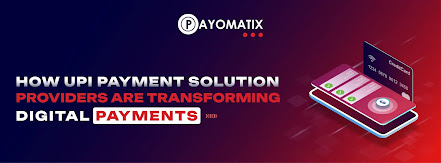5 Common Mistakes in Payment Gateway Integration and How to Avoid Them
“Is your payment system silently costing you conversions?”
Integrating a payment gateway should drive conversions—not hinder them. Yet, many businesses unknowingly make mistakes that lead to failed transactions, lost revenue, and frustrated users.
In this blog, we’ll uncover the 5 most common payment gateway integration mistakes and how to avoid them. We’ll also explore how Payomatix’s API-first architecture, robust software, and digital transaction management tools can supercharge your payment infrastructure.
Mistake #1 – Choosing the Wrong Payment Gateway
Many startups pick a gateway based on pricing or brand recognition. However, integration flexibility, compliance, and supported currencies are far more critical.
Impact:
-
Limited payment options
-
Low success rates
-
Cross-border issues
How to Avoid It:
-
Analyze your business model (E-commerce? SaaS? Marketplace?)
-
Ensure API-first integration support
-
Look for multi-currency support and PCI compliance
💡 Pro Tip:
Use Payomatix’s unified payment gateway to connect to global methods via one streamlined API.
Mistake #2 – Ignoring Mobile Optimization
With over 60% of transactions occurring on smartphones, mobile optimization is no longer optional.
Impact:
-
Unresponsive checkout flow
-
Increased cart abandonment
-
Slow loading times
How to Avoid It:
-
Use a responsive, mobile-first checkout UI
-
Integrate wallet payments and one-click options
-
Minimize checkout steps
✅ Solution:
Payomatix’s mobile-optimized checkout helps businesses deliver high-converting experiences across devices.
Mistake #3 – Not Handling Payment Failures Gracefully
Failures happen—insufficient funds, expired cards, or technical issues. But how you respond makes all the difference.
Impact:
-
Frustrated users
-
Lost revenue
-
No retry or fallback options
How to Avoid It:
-
Integrate smart retry logic
-
Offer alternate payment options
-
Notify users in real-time with actionable messages
🔧 With Payomatix, failures are automatically rerouted or retried using smart transaction routing.
Mistake #4 – Weak Error Logging and Monitoring
No monitoring = no visibility. If you can't track issues, you can’t resolve them quickly.
Impact:
-
Undiagnosed failures
-
Delayed issue resolution
-
Missed revenue opportunities
How to Avoid It:
-
Use dashboards with real-time tracking
-
Set automated alerts for drop-offs or anomalies
-
Analyze failed payments regularly
📊 Payomatix offers robust dashboards with real-time error monitoring and full transaction traceability.
Mistake #5 – Skipping Security and Compliance Essentials
Security is not just a formality—it's your defense against fraud, data breaches, and non-compliance.
Impact:
-
Higher risk of breaches
-
Legal penalties
-
Loss of customer trust
How to Avoid It:
-
Ensure PCI DSS compliance
-
Tokenize card data
-
Use fraud prevention tools
🔐 Payomatix is PCI DSS Level 1 certified, offering built-in fraud detection and secure tokenization by default.
How Payomatix Simplifies Payment Gateway Integration
From fast onboarding to developer-friendly APIs, Payomatix makes integration smooth and future-ready.
Key Features:
-
Unified API for global payment methods
-
Pre-built SDKs for all major platforms
-
Go live in as little as 48 hours
-
24/7 onboarding and support team
Whether you're running a D2C brand, SaaS platform, or marketplace, Payomatix offers scalable payment infrastructure without the technical burden.
The Role of Digital Transaction Management in Scaling Payments
Integration is just the beginning. Managing digital payments efficiently helps reduce errors and scale with confidence.
With Payomatix, you can:
-
Automate reconciliation and reporting
-
Streamline refunds and chargebacks
-
Generate invoices and tax summaries
-
Gain transaction-level insights
📈 Result: Better financial control, happy customers, and operational scalability.
Conclusion: Avoid Mistakes, Maximize Performance
Your payment system should fuel growth—not hinder it. By avoiding these common integration mistakes, you can improve conversion rates, streamline operations, and ensure secure transactions.
With Payomatix’s advanced payment gateway solutions, you get the tools and flexibility to build high-performing, secure, and scalable payment systems—without unnecessary complexity.
✅ Ready to Upgrade Your Payments?
Book a free consultation with the Payomatix team and explore how our platform can transform your payment operations.
FAQs
Q1: What are the common mistakes in payment gateway integration?
A: Common issues include choosing the wrong gateway, ignoring mobile optimization, not managing failures, weak monitoring, and skipping security.
Q2: How do I avoid payment gateway integration mistakes?
A: Use compatible APIs, optimize for mobile, handle failures smartly, monitor transactions, and ensure PCI compliance.
Q3: What is PCI compliance in payment gateways?
A: PCI compliance ensures your payment process meets security standards to protect customer data.
Q4: How does Payomatix improve payment gateway integration?
A: With a unified API, fast onboarding, mobile-ready features, and built-in fraud prevention.
Q5: Why is digital transaction management important?
A: It helps automate operations like reconciliation, refunds, tax generation, and real-time tracking.
.jpg)



Comments
Post a Comment